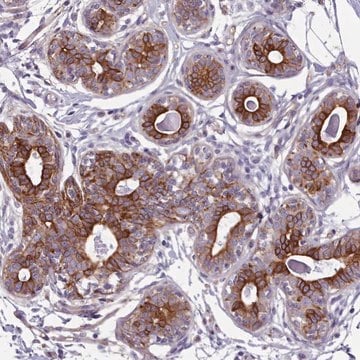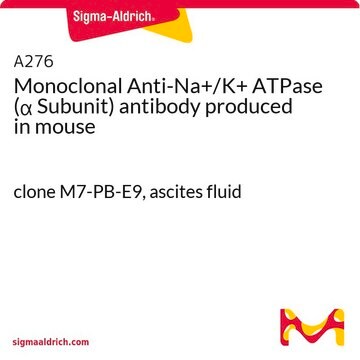MABT837
Anti-LBPA Antibody, clone 6C4
clone 6C4, from mouse
Synonym(s):
LBPA
About This Item
Recommended Products
biological source
mouse
Quality Level
antibody form
purified immunoglobulin
antibody product type
primary antibodies
clone
6C4, monoclonal
species reactivity (predicted by homology)
all
technique(s)
ELISA: suitable
dot blot: suitable
electron microscopy: suitable
immunocytochemistry: suitable
isotype
IgG1κ
shipped in
wet ice
target post-translational modification
unmodified
Gene Information
bacterial ... Lbpa(61281717)
General description
Specificity
Immunogen
Application
Immunocytochemistry Analysis: A representative lot detected late endosome LBPA immunoreactivity by fluorescent immunocytochemistry using MLN64-overexpressing MCF7 cells (Alpy, F., et al. (2001). J Biol Chem. 276(6):4261-4269).
Immunocytochemistry Analysis: A representative lot detected late endosome LBPA immunoreactivity in skin fibroblasts from healthy donors, as well as Niemann–Pick type C (NPC) and Tay-Sachs disease patients by fluorescent immunocytochemistry (Kobayahsi, T., et al. (1999). Nat Cell Biol. 1(2):113-118).
Immunocytochemistry Analysis: A representative lot detected late endosome LBPA immunoreactivity in baby hamster kidney (BHK) cells by fluorescent immunocytochemistry (Kobayahsi, T., et al. (1998). Nature. 392(6672):193-197).
Electron Microscopy Analysis: A representative lot detected similar cellular LBPA distribution in the skin fibroblasts from autosomal recessive Niemann–Pick type C disease (NPC) patients as seen in baby hamster kidney (BHK) cells (Kobayahsi, T., et al. (1999). Nat Cell Biol. 1(2):113-118).
Electron Microscopy Analysis: A representative lot detected LBPA immunoreactivity specifically associated with the late endosomes in baby hamster kidney (BHK) cells, but not the lgp120-positive limiting membranes of the same endosomes (Kobayahsi, T., et al. (1998). Nature. 392(6672):193-197).
ELISA Analysis: A representative lot specifically detected wells coated with total baby hamster kidney (BHK) cell lipid extract or purified LBPA, but not other lipids (PC, PE, SM, PS, CL, or PI) purified BHK lipid extract (Kobayahsi, T., et al. (1998). Nature. 392(6672):193-197)
Dot Blot Analysis: A representative lot specifically detected purified LBPA spotted on a HPTLC plate, but not other lipids (PC, PE, SM, PS, CL, PI, Sul, Chol, Cer, CE) purified from baby hamster kidney (BHK) cell lipid extract (Kobayahsi, T., et al. (1998). Nature. 392(6672):193-197).
Cell Structure
Adhesion (CAMs)
Quality
Immunocytochemistry Analysis: 4.0 µg/mL of this antibody stained late endosomes in HeLa cells.
Physical form
Storage and Stability
Other Notes
Disclaimer
Not finding the right product?
Try our Product Selector Tool.
Storage Class Code
12 - Non Combustible Liquids
WGK
WGK 1
Flash Point(F)
Not applicable
Flash Point(C)
Not applicable
Certificates of Analysis (COA)
Search for Certificates of Analysis (COA) by entering the products Lot/Batch Number. Lot and Batch Numbers can be found on a product’s label following the words ‘Lot’ or ‘Batch’.
Already Own This Product?
Find documentation for the products that you have recently purchased in the Document Library.
Our team of scientists has experience in all areas of research including Life Science, Material Science, Chemical Synthesis, Chromatography, Analytical and many others.
Contact Technical Service








